Premise
For any high-explosive anti-tank mine or grenade to be effective against armour, it must hit squarely on to the armour so that the high-velocity jet of metal punches through at a ninety degree angle. A way of making sure this happens is to place the charge onto the armour by hand. However, this puts the participant into grave danger from defensive fire from the tank and other enemies. A thrown version would be more versatile, but it would be hard to ensure the ninety degree angle.
The Panzerwurfmine is designed to achieve the stable flight needed by the deployment of large fins or canvas lengths at the back of the design, to stabilise the trajectory of the grenade and therefore make a ninety degree angle contact more likely. When the PWM hits the armour, the shaped charge is activated. However, in combat use the Panzerwurfmine often did not live up to expectations, due to the relatively short range it could be thrown, and also the relative lack of clean ninety degree impacts, decreasing its effectiveness.
Versions
The first version of the Panzerwurfmine was the Panzerwurfmine Lang ("long"). This weighed 1.36kg, and had a total length of 53.3 cm. It was stabilised by fins at the rear of the tube, that sprang out when the device was thrown. It was first introduced in May 1943, with 203,800 produced in that year. It was discontinued in favour of the Panzerwurfmine Kurz ("short"), which was stabilised by a canvas strip that rolled out when the device was thrown, and was also shorter.
Both designs had warheads with a diameter of 11.4cm, carrying a shaped charge of 500g that could penetrate approximately 150mm of RHA at zero degrees.
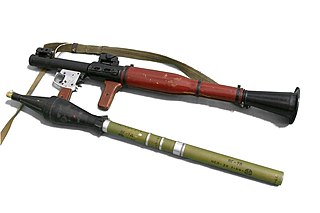
A rocket-propelled grenade (RPG) is a shoulder-fired rocket weapon that launches rockets equipped with an explosive warhead. Most RPGs can be carried by an individual soldier, and are frequently used as anti-tank weapons. These warheads are affixed to a rocket motor which propels the RPG towards the target and they are stabilized in flight with fins. Some types of RPG are reloadable with new rocket-propelled grenades, while others are single-use. RPGs are generally loaded from the front.

Armour-piercing ammunition (AP) is a type of projectile designed to penetrate armour protection, most often including naval armour, body armour, vehicle armour.

High-explosive anti-tank (HEAT) is the effect of a shaped charge explosive that uses the Munroe effect to penetrate heavy armor. The warhead functions by having an explosive charge collapse a metal liner inside the warhead into a high-velocity shaped charge jet; this is capable of penetrating armor steel to a depth of seven or more times the diameter of the charge. The shaped charge jet armor penetration effect is purely kinetic in nature; the round has no explosive or incendiary effect on the armor.

The Panzerfaust was a development family of single-shot man-portable anti-tank systems developed by Nazi Germany during World War II. The weapons were the first single-use light anti-tank weapons based on a pre-loaded disposable launch tube, a weapon configuration which is still used today.

Panzerschreck was the popular name for the Raketenpanzerbüchse 54, an 88 mm reusable anti-tank rocket launcher developed by Nazi Germany in World War II. Another earlier, official name was Ofenrohr.
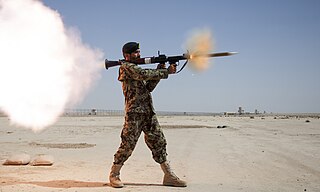
Shoulder-fired missile, shoulder-launched missile or man-portable missile, among other variants, are common slang-terms to describe high-caliber shoulder-mounted weapons systems – that is: weapons firing large heavy projectiles ("missiles"), typically using the backblast principle, which are small enough to be carried by a single person and fired while held on one's shoulder. The word "missile" in this context is used in its original broad sense of a heavy projectile, and encompasses all shells and rockets, guided or unguided. A more formal variant is simply shoulder-fired weapons system and the like.

The RPG-7 is a portable, reusable, unguided, shoulder-launched, anti-tank, rocket launcher. The RPG-7 and its predecessor, the RPG-2, were designed by the Soviet Union, and are now manufactured by the Russian company Bazalt. The weapon has the GRAU index 6G3.
A rifle grenade is a grenade that uses a rifle-based launcher to permit a longer effective range than would be possible if the grenade were thrown by hand.

The Grenade, Rifle No. 68 / Anti-Tank was a British anti-tank rifle grenade used during the Second World War and was one of the first operational weapons to utilise the shaped charge principle.
The Panzerfaust 3 is a modern semi-disposable recoilless anti-tank weapon, which was developed between 1978 and 1985 and first entered service with the Bundeswehr in 1987. It was first ordered in 1973 to provide West German infantry with an effective weapon against contemporary Soviet armor, thereby replacing West Germany's aging PzF 44 Light Lanze launchers and the heavy Carl Gustaf 84 mm anti-tank recoilless rifle manufactured in Sweden.
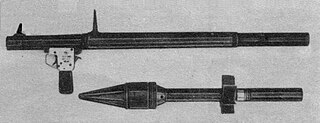
The RPG-2 is a man-portable, shoulder-fired anti-tank weapon that was designed in the Soviet Union. It was the first successful anti-tank weapon of its type, being a successor to the earlier and unsuccessful rocket-propelled grenade RPG-1.

RKG-3 is a series of Soviet anti-tank hand grenades. It superseded the RPG-43, RPG-40 and RPG-6 series, entering service in 1950. It was widely used in the 1973 Arab–Israeli War and remained a common weapon into the 2000s and early 2010s, being favoured by Iraqi insurgents during the American-led occupation. Modified versions of the RKG-3 series have also emerged in the Russian invasion of Ukraine.
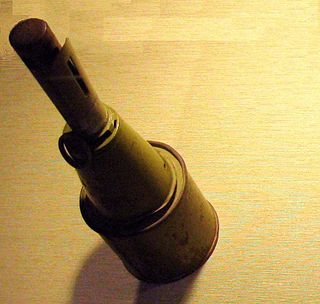
The RPG-43 was a high-explosive anti-tank (HEAT) shaped charge hand grenade used by the Soviet Union during World War II. It entered service in 1943, replacing the earlier models RPG-40 and RPG-41; the RPG-40 used a simpler high explosive (HE) warhead. The RPG-43 had a penetration of around 75 millimetres (3.0 in) of rolled homogeneous armour at a 90 degree angle. Later in the war, it was improved and became the RPG-6.
The RPG-1 was a Soviet lightweight anti-tank warfare rocket-propelled grenade (RPG) equipped with a shaped charge warhead. The design was inspired by similar weapons being introduced by the US and Germany in the late-World War II period. Work on the design began in 1944 and continued until 1948, but it was not put into production, as the RPG-2 was selected for this role instead. The RPG-1 introduced the basic physical and mechanical layout that was also used on the RPG-2 and the far more famous and ubiquitous RPG-7.

The RPG-6 was a Soviet-era anti-tank hand grenade used during the late World War II and early Cold War period. It was superseded by the RKG-3 anti-tank grenade.

The Hafthohlladung, also known as the "Panzerknacker", was a magnetically adhered, shaped charge anti-tank grenade used by German forces in World War II, and was sometimes described as a mine.
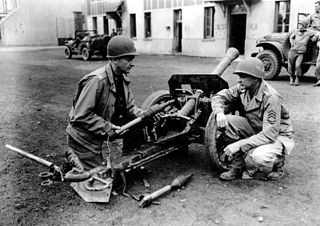
The 8.8 cm Raketenwerfer 43 Puppchen was an 88 mm calibre reusable anti-tank rocket launcher developed by Nazi Germany during World War II.
An anti-tank grenade is a specialized hand-thrown grenade used to defeat armored targets. Although their inherently short range limits the usefulness of grenades, troops can lie in ambush or maneuver under cover to exploit the limited outward visibility of the crew in a target vehicle. Hand launched anti-tank grenades became redundant with the introduction of standoff rocket propelled grenades and man-portable anti-tank systems.

Man-portable anti-tank systems are traditionally portable shoulder-launched projectile systems firing heavy shell-type projectiles, typically designed to combat protected targets, such as armoured vehicles, field fortifications and at times even low-flying aircraft.
The FT5 is a shoulder-launched, unguided and portable anti-tank rocket weapon. The weapon was built in South Africa by Somchem, a division of Denel based in Somerset West, now Rheinmetall Denel Munition. The weapon was designed with the primary function to provide soldiers with a weapon capable of destroying armoured fighting vehicles and modern main battle tanks. The weapon also has a secondary function of destroying bunkers and other fortifications.














